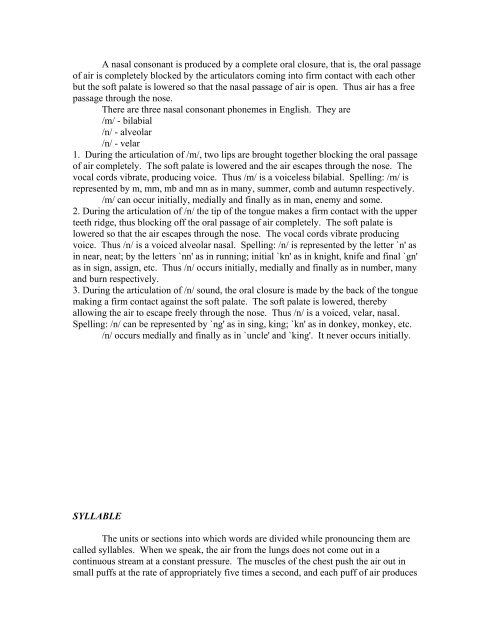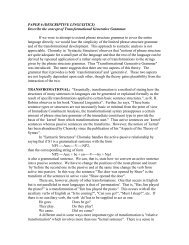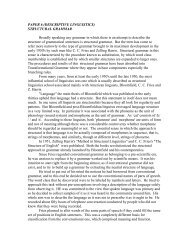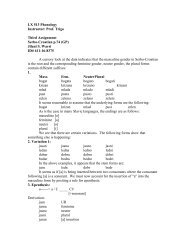PAPER 6 (DESCRIPTIVE LINGUISTICS ... - Jilani S. Warsi
PAPER 6 (DESCRIPTIVE LINGUISTICS ... - Jilani S. Warsi
PAPER 6 (DESCRIPTIVE LINGUISTICS ... - Jilani S. Warsi
Create successful ePaper yourself
Turn your PDF publications into a flip-book with our unique Google optimized e-Paper software.
A nasal consonant is produced by a complete oral closure, that is, the oral passage<br />
of air is completely blocked by the articulators coming into firm contact with each other<br />
but the soft palate is lowered so that the nasal passage of air is open. Thus air has a free<br />
passage through the nose.<br />
There are three nasal consonant phonemes in English. They are<br />
/m/ - bilabial<br />
/n/ - alveolar<br />
/n/ - velar<br />
1. During the articulation of /m/, two lips are brought together blocking the oral passage<br />
of air completely. The soft palate is lowered and the air escapes through the nose. The<br />
vocal cords vibrate, producing voice. Thus /m/ is a voiceless bilabial. Spelling: /m/ is<br />
represented by m, mm, mb and mn as in many, summer, comb and autumn respectively.<br />
/m/ can occur initially, medially and finally as in man, enemy and some.<br />
2. During the articulation of /n/ the tip of the tongue makes a firm contact with the upper<br />
teeth ridge, thus blocking off the oral passage of air completely. The soft palate is<br />
lowered so that the air escapes through the nose. The vocal cords vibrate producing<br />
voice. Thus /n/ is a voiced alveolar nasal. Spelling: /n/ is represented by the letter `n' as<br />
in near, neat; by the letters `nn' as in running; initial `kn' as in knight, knife and final `gn'<br />
as in sign, assign, etc. Thus /n/ occurs initially, medially and finally as in number, many<br />
and burn respectively.<br />
3. During the articulation of /n/ sound, the oral closure is made by the back of the tongue<br />
making a firm contact against the soft palate. The soft palate is lowered, thereby<br />
allowing the air to escape freely through the nose. Thus /n/ is a voiced, velar, nasal.<br />
Spelling: /n/ can be represented by `ng' as in sing, king; `kn' as in donkey, monkey, etc.<br />
/n/ occurs medially and finally as in `uncle' and `king'. It never occurs initially.<br />
SYLLABLE<br />
The units or sections into which words are divided while pronouncing them are<br />
called syllables. When we speak, the air from the lungs does not come out in a<br />
continuous stream at a constant pressure. The muscles of the chest push the air out in<br />
small puffs at the rate of appropriately five times a second, and each puff of air produces





